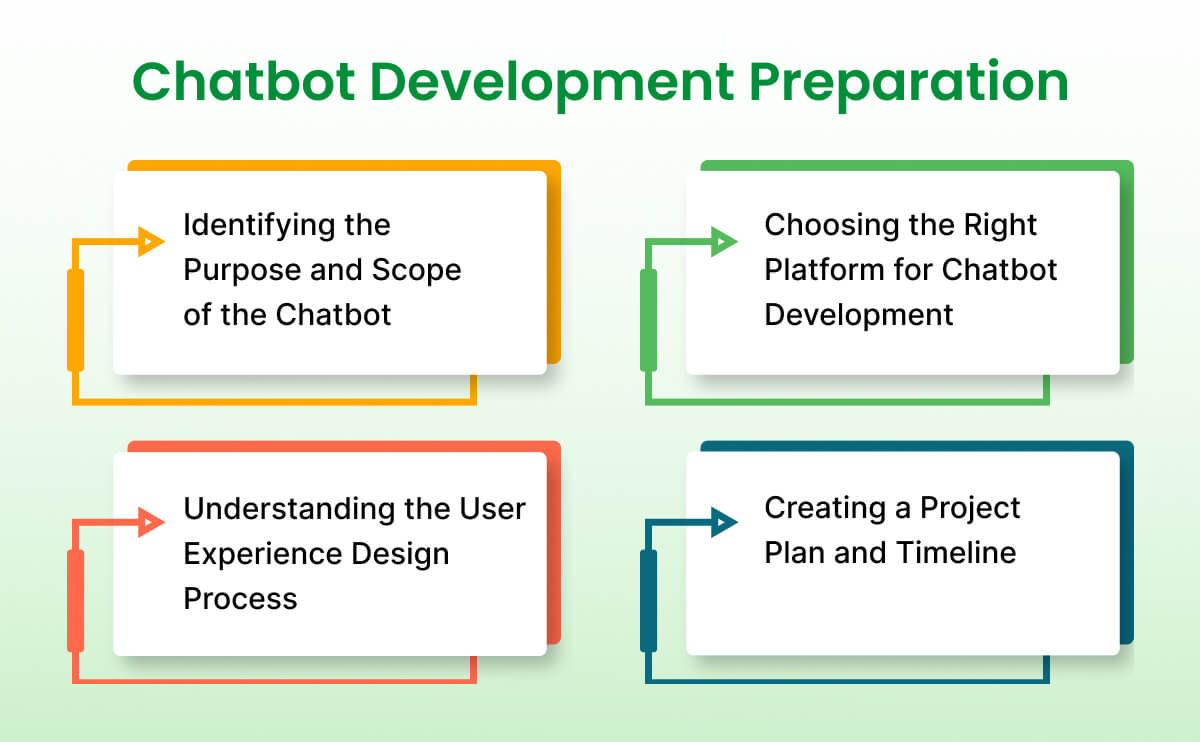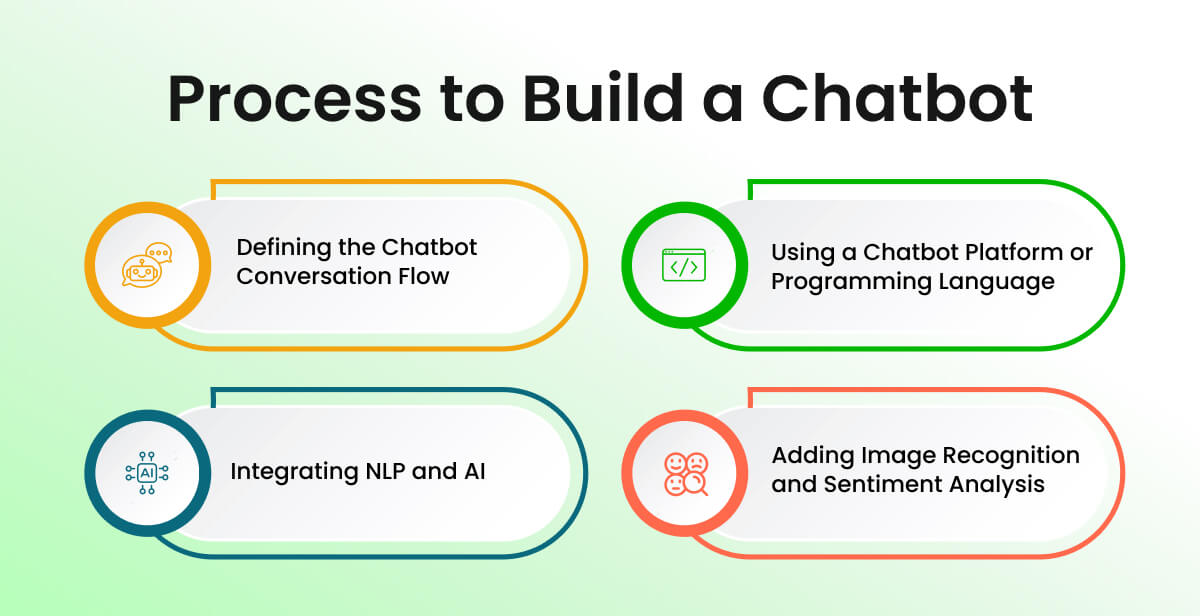 Chatbot
Chatbot

17 April, 2023

In a world where technology reigns supreme, the rise of chatbots has been nothing short of revolutionary. These artificial intelligence-powered programs have taken the world by storm, infiltrating everything from customer service to personal assistants. But what exactly is a chatbot? Simply put, a chatbot is a computer program designed to simulate conversation with human users, often through instant messaging apps, websites, or voice assistants.
Not all chatbots are created equal. In fact, a variety of chatbots are usually developed to suit a wide range of needs. Some bots are designed to perform specific tasks, such as answering FAQs (frequently asked questions), while others are designed to engage in more complex conversations and even generate leads for businesses.
So, if you wonder how to make a chatbot for your dream company, look no further. This comprehensive guide will walk you through the process step-by-step, from choosing a platform to designing your bot’s personality and dialogue.
Contents
This preparation is very much necessary to ensure that the chatbot meets the needs of its users and achieves its intended goals. Without proper preparation, the chatbot may fail to provide an engaging and helpful user experience, or it may not integrate effectively with other applications and systems.
.By taking the following steps, developers can create a chatbot that is effective, efficient and meets the needs of its users, ultimately contributing to the success of the business or organization it serves.

This is the first step which involves understanding the problem that the chatbot is meant to solve and the audience it will serve. A well-defined purpose and scope will help you create a chatbot that meets the needs of your users.
To do this, you should start by identifying the problem or need that your chatbot is intended to address. You should also define your target audience and what they expect from the chatbot. Additionally, you should define the type of interactions your chatbot will have with users, such as providing customer support, answering frequently asked questions, or providing personalized recommendations.
There are many platforms available, and choosing the right one will depend on your goals, budget, and technical expertise.
Some popular platforms for chatbot development include Dialogflow, Microsoft Bot Framework, and Amazon Lex. These platforms offer a range of features, including natural language processing, machine learning, and integration with other applications.
Before choosing a platform, you should consider factors such as ease of use, cost, scalability, and the availability of third-party integrations.
Creating a successful chatbot requires a strong focus on user experience design. This involves designing a chatbot that is easy to use, engaging, and helpful for users. To achieve this, you need to understand the user experience design process.
The user experience design process typically involves several steps, including user research, prototyping, and testing. User research involves gathering information about your target audience and their needs. Prototyping involves creating a basic version of your chatbot and testing it with users to identify any usability issues. Finally, testing involves refining the chatbot based on user feedback to create a more effective and engaging user experience.
This will help you ensure that your chatbot development project stays on track and meets its objectives.
To create a project plan, you should start by defining the scope of the project, setting goals, and identifying key milestones. You should also identify the resources you will need, such as developers, designers, and content creators.
Once you have defined the project plan, you can create a timeline that outlines the key tasks and deadlines. This will help you keep track of progress and ensure that your chatbot is completed on time and within budget.
Overall, preparing for chatbot development requires careful planning and a focus on user experience design. By following these steps, you can create a chatbot that meets the needs of your users and helps you achieve your business objectives.
When you are ready to Build a chatbot, you are going to deal with creating an interactive software application that can mimic human conversation and respond to user inquiries or commands. The chatbot can be designed to engage in text or voice-based conversations, using natural language processing (NLP) and artificial intelligence (AI) to understand and respond to user inputs. Let’s have a glimpse of the chatbot factory by walking through the following key steps.

This involves mapping out the different scenarios or situations where users may interact with the chatbot and identifying the types of responses or actions the chatbot should take in each situation. A conversation flow diagram can help visualize the different paths and decision points in the chatbot’s interactions with users.
There are many chatbot-building platforms available, such as Dialogflow, IBM Watson, and Microsoft Bot Framework, that provide pre-built tools and templates for creating chatbots. Alternatively, developers can build a chatbot from scratch using programming languages such as Python or JavaScript.
To make the chatbot more intelligent and able to understand and respond to user inputs, NLP and AI technologies need to be integrated. NLP helps the chatbot understand the user’s language and context, while AI enables the chatbot to make informed decisions and provide relevant responses. There are many NLP and AI libraries and tools available for developers to use, such as spaCy, NLTK, and TensorFlow.
Chatbots can be enhanced with a variety of features to improve their functionality and provide a more seamless user experience. Here are some of the most popular features that can be added to chatbots:
It allows chatbots to identify images and provide relevant responses based on the content of the image. For example, a chatbot for a clothing store could use image recognition to identify clothing items in a customer’s photo and provide recommendations.
This is a tool that can be used to analyze the emotional tone of a message. By incorporating sentiment analysis, chatbots can detect negative or positive sentiments and tailor their responses accordingly.
This allows chatbots to tailor their responses to individual users based on their preferences, history, and behavior. By incorporating personalization, chatbots can provide a more customized and engaging user experience.
It enables chatbots to understand and respond to spoken language. By incorporating speech recognition, chatbots can provide a more natural and intuitive user experience.
Chatbots can be integrated with other applications such as social media, e-commerce platforms, and customer relationship management systems to provide a seamless user experience across different platforms.
This is a process that involves a series of activities to ensure that it meets the needs of its users. If truly are a result-oriented business leader, let’s unwrap some steps to follow for a better customer experience.
The very first step aims to gather feedback for deploying the ultimate software. This involves identifying a group of beta testers who can use the chatbot and provide feedback on its performance. The testers should be representative of the target audience for the chatbot. You can use tools such as UserTesting or UsabilityHub to conduct remote user testing.
The next step is all about analyzing the feedback and identifying the zones where the chatbot app can be improved. You can then make the necessary adjustments to the chatbot to improve its performance.
Now it is time to deploy the chatbot on the chosen platform. In this case, you need to integrate the chatbot with the platform and ensure that it is functioning properly. The platform you choose will depend on your specific needs and the target audience for the chatbot. Some popular platforms for chatbot deployment include Facebook Messenger, Slack, and WhatsApp.
All deployment is done, now the final step is to monitor its performance. For this, you will need to use tools such as Google Analytics or Mixpanel to track user engagement with the chatbot. You can use this data to identify areas where the chatbot can be further improved and to optimize its performance over time.
If you intend to control your creation, you need to go through some procedures to ensure it functions efficiently and effectively. Let’s clarify them to make your chatbot long-lusting.
One of the most important aspects of maintaining a chatbot is identifying and resolving issues and bugs that may arise. This could involve monitoring user interactions to identify areas where the chatbot may be struggling to provide accurate responses or encountering errors. Once issues are identified, the development team can work to resolve them and make necessary updates to prevent future occurrences.
A chatbot’s success depends on its ability to meet the needs of its users. As such, it’s crucial to gather feedback from users and use that feedback to inform updates and improvements. This could involve adding new capabilities to the chatbot, such as the ability to answer new types of questions or provide additional resources. By incorporating user feedback, chatbot developers can ensure that the chatbot is providing the most valuable and relevant information to its users.
Business needs and the technology landscape are constantly evolving, and chatbot developers need to stay up-to-date with these changes to ensure their chatbots remain relevant and effective. This could involve updating the chatbot to incorporate new technologies or platforms or making changes to the chatbot’s responses to align with changes in business strategy. By staying on top of these changes, chatbot developers can help ensure that the chatbot continues to provide value and meet the needs of its users.
When it comes to turning the principles of how to make chatbots into practices the audience must be laser-targeted. Moreover, in the case of user-friendliness and easy-to-navigate criteria, you should focus on simplicity and intuitiveness. You also must ensure that you provide clear instructions and feedback to users. This is actually an endless journey of advancement if you think about the potential of chatbot technology.
Chatbots are becoming increasingly sophisticated and capable of handling complex tasks. From customer service to healthcare, education, and beyond, chatbots have the potential to revolutionize the way you interact with each client. Thus, a whole new horizon of efficiency, productivity, and customer satisfaction can be unwrapped before you.